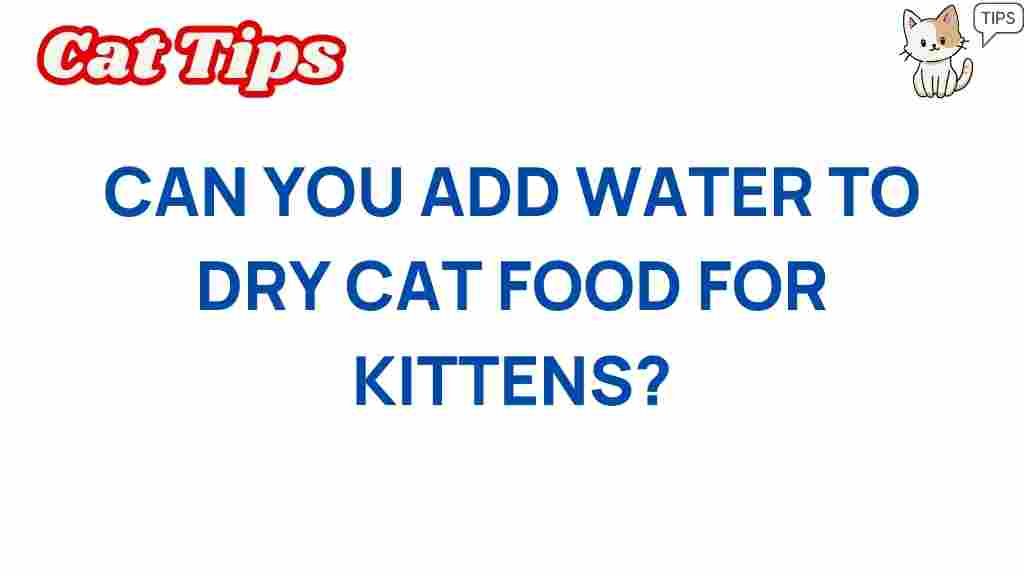Can Adding Water to Dry Cat Food Transform Your Kitten’s Diet?
As a cat owner, you want the best for your kitten, and that includes their diet. With various options available, including canned, raw, and dry cat food, it can be challenging to determine what will provide the best nutrition for your furry friend. One often overlooked option is adding water to dry cat food. This simple adjustment can significantly impact your kitten’s health and hydration. In this article, we will explore how adding water to dry cat food can transform your kitten’s diet.
The Benefits of Dry Cat Food
Before diving into the specifics of adding water to dry cat food, it’s essential to understand the benefits of dry cat food itself. Here are some reasons why dry cat food is a popular choice among pet owners:
- Convenience: Dry cat food is easy to store and serve, making it a hassle-free option for busy pet owners.
- Cost-Effective: Generally, dry cat food is less expensive than wet options, allowing you to feed your kitten a high-quality diet without breaking the bank.
- Dental Health: The crunchy texture of dry cat food can help reduce plaque and tartar buildup, promoting better dental health.
- Long Shelf Life: Dry cat food can last longer than wet food, reducing waste and ensuring you always have food on hand.
Why Hydration Matters
Hydration is crucial for your kitten’s overall health. Cats often have a low thirst drive, primarily if they are fed dry cat food. This can lead to chronic dehydration, which may result in urinary tract issues and kidney problems. By adding water to dry cat food, you can help ensure your kitten receives adequate hydration.
How to Add Water to Dry Cat Food
Transforming your kitten’s diet by adding water to dry cat food is a straightforward process. Here’s a step-by-step guide on how to do it:
Step 1: Choose the Right Water
Your kitten should have access to clean, fresh water at all times. For this process, use filtered or bottled water if you are concerned about the quality of tap water in your area. Ensuring the water is free from contaminants will enhance the overall health benefits.
Step 2: Measure the Dry Cat Food
Start by measuring the appropriate amount of dry cat food for your kitten. Follow the feeding guidelines on the food packaging based on your kitten’s age, weight, and activity level.
Step 3: Add Water
Once you have measured the dry cat food, add water to it. A good rule of thumb is to use a ratio of 1 part water to 2 parts dry cat food. You can adjust this ratio based on your kitten’s preferences. Here’s how to do it:
- Pour the dry cat food into a bowl.
- Add the measured water.
- Allow it to soak for about 10-15 minutes. This will soften the kibble, making it easier for your kitten to eat.
Step 4: Serve and Observe
Once the dry cat food has softened, serve it to your kitten. Observe how they react to the new texture and moisture level. Some kittens may take a little time to adjust, while others may love it immediately!
Step 5: Regularly Change the Water
To maintain optimal hydration, ensure that you regularly change the water used to soak the dry cat food. This will prevent any bacterial growth and provide your kitten with fresh hydration.
Troubleshooting Tips
While adding water to dry cat food can have numerous benefits, you may encounter some challenges. Here are some troubleshooting tips to help you through the process:
1. Kitten Refuses to Eat
If your kitten seems hesitant to eat the softened dry cat food, consider the following:
- Gradually introduce the new texture. Start by mixing a small amount of wet food with the soaked dry cat food.
- Experiment with different water temperatures—some kittens prefer warm water.
- Try adding a small amount of low-sodium broth to enhance the flavor.
2. Excessive Moisture
If you notice that the food is too soupy, reduce the amount of water you are adding. You want to create a moist texture without making it overly liquid.
3. Changes in Litter Box Habits
After changing your kitten’s diet, you may notice changes in their litter box habits. This can include more frequent urination or different stool consistency. If these changes persist, consult your veterinarian.
Conclusion
Adding water to dry cat food can indeed transform your kitten’s diet and improve their hydration levels. Not only does this simple step make your kitten’s food more appealing, but it also contributes to their overall health. Remember to monitor their response to the changes, and adjust the water levels and food types as needed.
For more tips on pet care and nutrition, make sure to check out our other articles on cat health and wellness. Your kitten deserves the best, and with a little effort, you can provide them with a diet that supports their growth and vitality.
In summary, incorporating water into your kitten’s dry cat food can lead to a happier, healthier life for your furry friend. Start today and observe the positive changes in your kitten’s well-being!
If you want to learn more about the importance of hydration for pets, visit PetMD’s resource on pet hydration.
This article is in the category Nutrition and created by CatTips Team
